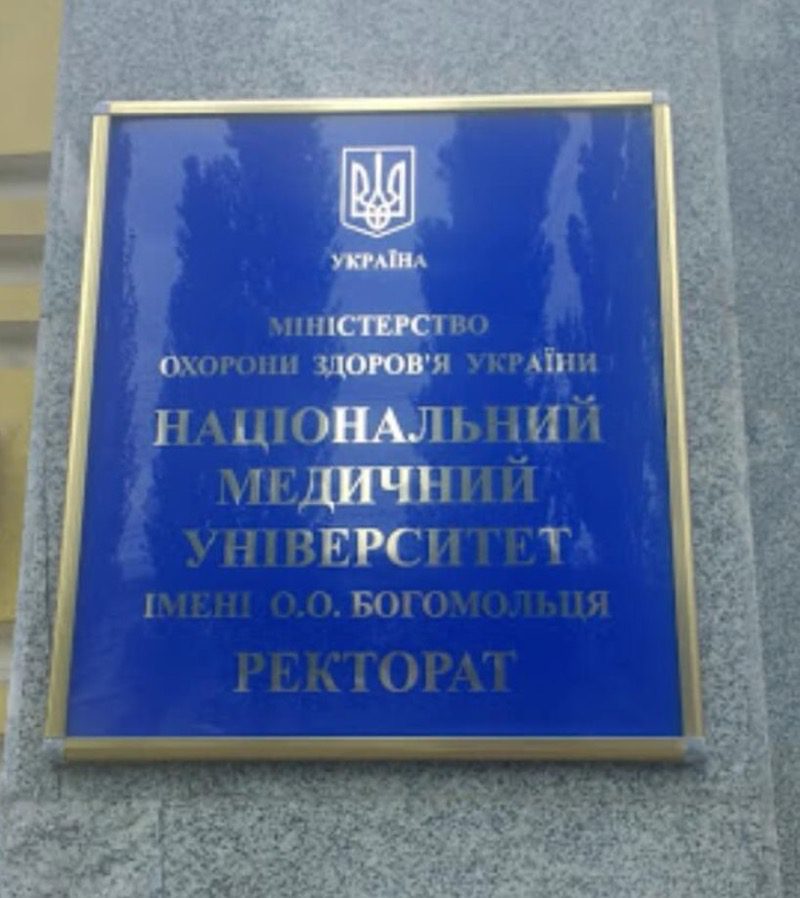Institutions where you can get higher medical education in Ukraine
Medical schools in Ukraine attract not only Ukrainians but also people from near and far abroad. In this article, we will review the top ten medical schools in Ukraine that train personnel for national and foreign healthcare institutions.
We have selected the most renowned and respected medical education institutions. The list was compiled on the basis of information from the Internet, national rankings and surveys.

Criteria for choosing higher medical education institutions
We selected medical facilities based on the following criteria:
- popularity among applicants
- areas of training
- different specializations
- prestige
- scientific robot
- presence of prominent alumni and employees
Rating of medical educational institutions of Ukraine
The ranking of medical schools in Ukraine presented in this publication is based on publicly available information. All universities and medical academies are located in major Ukrainian cities.
Almost every regional center has an institution where you can get medical education. After the work done, our rating has been compiled into the following list:
1. Bogomolets National Medical University.
2. Danylo Halytsky Lviv National Medical University. Danylo Halytskyi National Medical University
3. Ternopil National Medical University named after I.Y. Gorbachevsky. Gorbachevsky National Medical University
4. Odesa National Medical University
5. Kharkiv National Medical University
6. Ukrainian Military Medical Academy
7. National University of Pharmacy
8. Pirogov Vinnytsia National Medical University. Pirogov National Medical University
9. Bukovinian State Medical University
10. Dnipropetrovs’k Medical Academ
1. Bogomolets National Medical University. Bogomolets National Medical University
The university, which is one of the leading and most renowned higher medical education institutions, has its roots in the XIX century. The predecessor of the modern NMU is the Medical Faculty of St. Volodymyr’s University of Kyiv, established by the order of Emperor Nicholas I in 1840.
Currently, NMU offers medical education at ten faculties. They include 87 departments in all major areas of modern medicine. In addition to educational units, it also includes two research institutes.
2. Danylo Halytsky Lviv National Medical University
The history of Lviv National Medical University dates back to the 18th century. In fact, it is a direct successor of the Medical Faculty of Lviv University, which was founded in 1784 by the Austrian Emperor Joseph II. Even then, there was an opportunity to obtain medical education in Lviv.
Today, it is a multidisciplinary higher medical educational institution with a modern material and technical base. The university includes:
- 14 educational buildings
- 41 clinical sites
- pharmacy
- student dental clinic.
Clinical departments exist at regional, city and railway hospitals. Similar units have been set up at Military Hospital 1120 and the Clinical Hospital of the State Border Guard Service of Ukraine. All departments have the most modern diagnostic and treatment equipment at their disposal.
Lviv National Medical University has a large library. Its collection includes more than 540 thousand volumes of educational and scientific literature in all fields of medicine.
In addition, LNMU has its own Botanical Garden.
Facultati
Today, this higher medical education institution consists of seven faculties:
- two medics
- dental
- full-time and part-time pharmacists
- of the Faculty of Postgraduate Education
- Faculty of foreign students
Specialists of three educational levels graduate: bachelors, specialists and masters. For those with a higher medical education, postgraduate programs in 32 specialties and doctoral programs in 6 specialties are available.
The Faculty of Postgraduate Education has branches in medical institutions in Lutsk, Rivne and Truskavets.
The scientific and pedagogical staff of the medical school works at 79 departments and subordinate institutions. These are the Institute of Clinical Pathology, the Central Research Laboratory and the Laboratory of Industrial Toxicology.
3. Ternopil National Medical University named after I.Y. Gorbachevsky.
Ternopil National Medical Institute was founded on April 12, 1957. In 1992, the institute was named after I.Y. Gorbachevsky, a prominent scientist and academician of the National Academy of Sciences of Ukraine. In 1997, on January 30, the Institute was granted the status of a medical academy.
However, in 2004, the Academy was reorganized into the Ternopil State Medical Institute named after I.Y. Gorbachevsky. Gorbachevsky Ternopil State Medical Institute. The last reorganization of the university took place in 2019, namely on April 17, and today it is called “Gorbachevsky Ternopil National Medical University named after I.Y. Gorbachevsky”. Gorbachevsky National Medical University”. It is headed by Mykhailo Korda, MD and professor.
Institutes and faculties of the university:
- Educational and Research Institute of Morphology
- N.P. Skakun Educational and Research Institute of Pharmacology, Hygiene and Medical Biochemistry
- Educational and Research Institute of Biomedical Problems
- Educational and Research Institute of Postgraduate Education
- Educational and Research Institute of Nursing
- Educational and Research Institute of Modeling and Analysis of Pathological Processes
- Faculty of Medicine
- Faculty of Dentistry
- Faculty of foreign students
- Faculty of Pharmacy
Gorbachevsky Ternopil National Medical University cooperates with the Clinic of Laser and Cell Medicine Gorbachevsky Ternopil National Medical University cooperates with the Clinic of Laser and Cell Medicine Coolaser Clinic in the field of cellular technologies.
The use of stem cells is advisable in such cases:
- Treatment of somatic diseases
- Therapy for severe autoimmune diseases
- Treatment of severe neurodegenerative diseases
- Therapy of cardiovascular diseases
- Also for the purpose of regeneration and rejuvenation of the body
4. Odesa National Medical University
Medical University in Odesa is a higher medical educational institution with more than a century of history. It was founded by N.I. Pirogov himself, who supported the initiative to open it in 1900, initially as one of the faculties of Novorossiysk University.
A little later, the faculty was transformed into a separate institute. The university status was granted to this educational institution in modern times, in 1994. In 2010, it was granted the right to be called “national”.
Faculties
Odesa National Medical University consists of eight faculties:
- medical schools No. 1 and 2, which provide training in the specialty “Medical care”
- Medical School No. 3, which trains pediatricians
- medical №4 (specialty – “Medical and preventive care”)
- of the Faculty of Dentistry
- of the Faculty of Pharmacy
- of the Faculty of Postgraduate Education
- of the international faculty
Chairs
The university consists of 43 clinical departments located in 63 medical institutions of Odesa and Odesa region. All of them have their own websites with teaching materials in Ukrainian, Russian and English. For the continuous medical education of doctors and pharmacists, the University of Odesa has organized the Center for Distance Education.
5. Kharkiv National Medical University
This higher medical educational institution is one of the most famous and respected educational institutions in Ukraine. KhNMU originates from the Department of Medicine and Medical Sciences of the Imperial Kharkiv University founded in 1804.
The university has nine faculties:
- 3 faculties provide training in the specialty “Medicine”
- 1 faculty – in the specialty “Medicine” and “Pediatrics”
- 3 faculties are engaged in training of foreign students in the specialty “Medicine”
- 1 dental faculty
- 1 факультет післядипломної освіти.
The educational process involves 64 departments and 6 scientific and practical educational associations. Areas of their work: “Therapy”, “Medical Genetics”, “Urology”, “Surgery”, “Obstetrics and Gynecology”, “Medradiology”.
In addition, the higher medical school has a Medical College that trains nursing staff.
6. Ukrainian Military Medical Academy
The Military Medical Academy is a higher medical educational institution of a wide profile. It provides postgraduate training, retraining and advanced training for doctors to staff the medical service of the Armed Forces. There is also the possibility of training foreign citizens.
Graduates of the medical academy are awarded the qualifications of a specialist doctor, general pharmacist, master of medicine or pharmacy.
The main structural subdivisions of a higher medical education institution are:
- Faculty of Military Doctors Training
- Faculty of retraining and advanced training
Faculty of Military Doctors Training
Military doctors are trained in 14 specialties. The training lasts three years for surgeons and general practitioners. Doctors of preventive and therapeutic medicine, dentists and pharmacists are trained for two years.
After graduation and state certification, students receive a master’s degree in medicine or pharmacy. They also receive a certificate for the right to practice medicine or pharmacy independently. After that, they can be appointed to positions in the medical units of the Armed Forces.
Faculty of retraining and advanced training
The Faculty of Retraining and Advanced Training conducts secondary specialization of medical workers. Both doctors and pharmacists are trained.
Professional retraining for doctors is ongoing:
- 43 cycles of thematic improvement
- 37 cycles of professional development
- 37 pre-certification cycles.
In addition, junior medical staff is retrained at this faculty. There are 16 cycles of technical improvement and 10 cycles of specialization.
Training cycles last from one to nine months, depending on the type of specialisation and improvement and the level of qualification of the medical staff.
7. National University of Pharmacy
Like the Kharkiv National Medical University, the National University of Pharmacy is an outgrowth of the Faculty of Medical and Pharmaceutical Sciences of the Imperial Kharkiv University. It began training pharmacists in 1805.
This institution of higher medical education provides education at bachelor, specialist and master level.
There are four faculties:
- Pharmaceutical;
- of pharmaceutical technology and management;
- Medical and pharmaceutical technologies;
- Faculty for the education of foreign citizens.
More than 90% of the faculty hold a doctorate or PhD.
The University publishes regular scientific journals such as
- “Pharmacy Bulletin
- “Clinical Pharmacy
- “Journal of Organic and Pharmaceutical Chemistry
- “Management, Economics and Quality Assurance in Pharmacy
- The “Youth of Pharmacy” newspaper.
8. Pirogov National Medical University of Vinnytsia
Vinnytsia National Medical University was established in 1921. At that time it was called Vinnytsia Pharmaceutical Institute, and later, in 1960, it was named after the prominent surgeon M.I. Pirogov. In 1994, Vinnytsia Medical Institute was granted the status of a university;
The university was granted the right to be called “national” in 2002, and at the same time was awarded diplomas from the Cabinet of Ministers of Ukraine and the Verkhovna Rada of Ukraine.
Today, the university consists of 60 departments, 19 of which are theoretical and 41 are clinical. Twelve scientific schools are represented at Pirogov National Medical University;
Students are taught by 136 doctors and 686 candidates of sciences:
- 25 Honored Workers of Science and Technology of Ukraine
- Honored Worker of Higher Education and Education of Ukraine
- 4 academicians of the Academy of Sciences of Ukraine
- 13 honored doctors of Ukraine
- 8 Laureates of the State Prize of Ukraine.
The faculty members of the departments participate in the implementation of 62 international projects. In 1984, the medical school was awarded the Order of the Badge of Honor;
This medical school maintains scientific ties with medical faculties of universities in nineteen countries. Among them are American, German, French, British and Polish universities. Clinical departments have close ties with 28 foreign pharmaceutical companies;
9. Bukovinian State Medical University9. Bukovinian State Medical University
Bukovinian State Medical University is a higher medical educational institution located in the city of Chernivtsi. The university originates from the 2nd Kyiv Medical Institute, which was transferred to Chernivtsi in October 1944.
Specialists are trained in the following specialties:
- “Medical business”
- “Pediatrics”
- “Medical psychology”
- “Dentistry”
- “Clinical Pharmacy”
- “Pharmacy”
- “Laboratory diagnostics”
- “Nursing”
The BSMU provides postgraduate training for practicing doctors, and the postgraduate education programs include
- Internships
- Clinical residency
- Master’s programs
- Postgraduate programs
- Doctoral programs.
In addition, pre-certification cycles, internship cycles, thematic improvement and specialization are held.
Today, the medical school is a part of the educational institution:
- four medical faculties
- dental faculty
- pharmaceutical faculty
- Educational and Research Institute of Postgraduate Education
- medical lyceum
- four medical colleges: Novoselytsia, Chernivtsi, Vashkovets, and Kovel.
- preparatory department for international students.
10. Dnipropetrovs’k Medical Academy10. Dnipropetrovs’k Medical Academy
DMA is one of the oldest higher medical educational institutions in Ukraine. The date of establishment of the educational institution is considered to be September 15 1916. At that time, the Academy was founded on the basis of the Katerynoslav Higher Women’s Courses. On March 16, 2021, by order of the Ministry of Health of Ukraine, the institution received the status of a university.
The structure of the medical academy includes six faculties:
- two medical
- dental
- two international
- Faculty of Postgraduate Education.
In total, more than 4,500 students and medical students study at these faculties.
The educational process is provided by 59 departments, in particular:
- 42 departments of clinical specialization, which employ 646 teachers, of whom 359 have a PhD and 98 have a doctorate.
Clinical departments are located at 28 hospitals. In addition, 29 specialized centers are organized at the clinical bases of the medical academy.
Results of the review of medical schools
To summarize the review of higher medical education institutions in Ukraine presented in this article, it should be noted that the country has a high level of training of qualified medical personnel. First of all, this applies to senior staff – doctors and pharmacists. We should not forget about the middle medical staff: nurses, midwives and paramedics.
All major cities of Ukraine have educational institutions that train doctors. A fairly high percentage of universities have a rich history and continuity of academic staff dating back to pre-revolutionary times.
All medical schools are equipped with modern facilities. Alongside their educational activities, they also conduct research and maintain contacts with foreign universities and clinics, including Western European and American ones.






